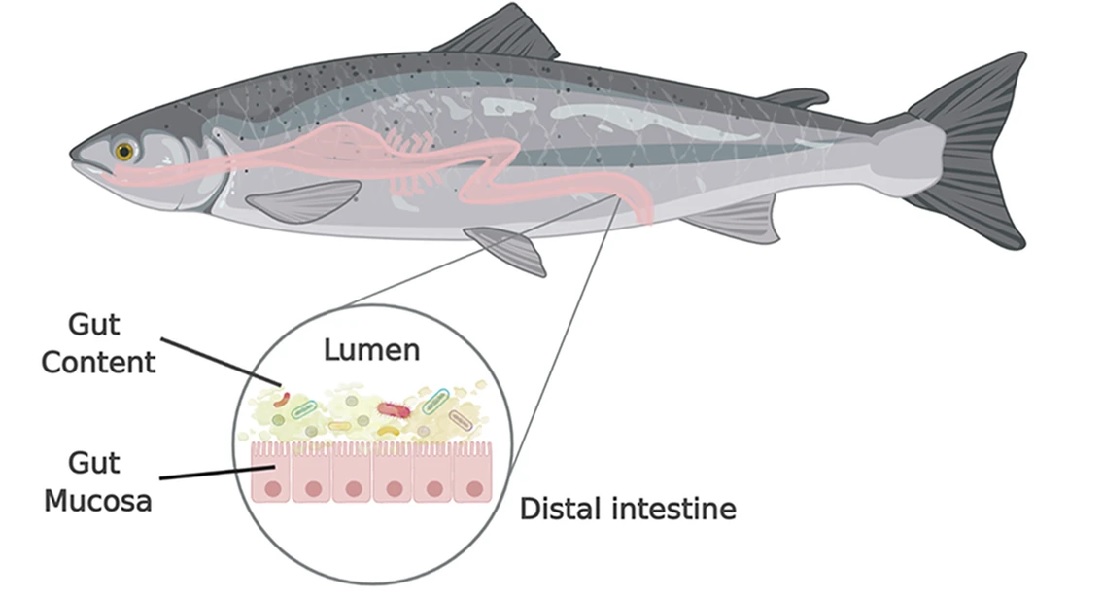New study reveals correlation between salmon health and gut microbiome
Researchers from the Center of Evolutionary Hologenomics have revealed a correlation between gut microbiota and disease infection status in farmed salmon, offering a better understanding of fish population health and disease. The reported discoveries can help to boost efficiency and sustainability in aquaculture through improved disease monitoring strategies and optimized treatments.

As the fastest growing food sector worldwide, aquaculture will constitute an essential animal protein source for the growing human population in the future. As a consequence, there are significant benefits, both economically and environmentally, to improve infectious disease detection strategies and reduce production losses.
This gap in knowledge is exactly what MSc graduate Davide Bozzi, Associate Professor Morten Limborg and colleagues from the Center of Evolutionary Hologenomics have addressed in a newly published research paper in the journal Animal Microbiome. This publication identifies potential solutions and improvements to one of the primary challenges of aquaculture: farmed fish disease prevention and management.
It is known amongst experts that salmon farming can frequently face disease outbreaks affecting the skin tissue. A common treatment for these is a formalin bath. However, what impact the disease or treatment has on the gut microbiome was unknown, as it was not the site of primary infection. A more holistic picture of the issue was therefore needed.
“We cannot properly address the fish health issue without taking their microbiome into consideration,” says Davide Bozzi, the lead author of the paper. “That’s because it’s the holobiont, the fish host plus its microbiome, as a unit that experiences the disease. If we don’t consider all the parts involved, we will never get the full picture.”
By sampling the gut microbiomes of sick and healthy fish before and after treatment it was possible to not only identify the offending pathogen, Tenacibaculum dicentrarchi, but also find a correlation between the unhealthy fish and their gut microbiomes. Moreover, the subsequent formalin treatment bath also affected the treated fish gut microbiome, signifying the long-term impacts of traditional treatment methods.
This finding is important as it suggests that a crucial part of treating salmon disease should also focus on the restoration of the gut microbiota to a healthy state with the use of for example probiotics. Together these results proved how a more holistic approach, even in cases where the disease does not appear to target the gut, can be insightful for fish health and treatments.
Morten Limborg, Associate Professor at Center for Evolutionary Hologenomics, notes that “There are two truly novel findings coming out of this study. First, we show that an external skin infection also affects the gut microbiome inside the fish; something that has been ignored previously. Second, our results document some striking correlations between specific bacteria and fish health which can be used to more efficiently monitor animal health and earlier detection of diseases.”
The gut microbiota reveals new ways to monitor salmonid health
The gut microbiome composition also holds the potential key to effectively gauge the health of fish populations. The study revealed that a bacteria, part of a new fish-associated Mycoplasma genus, was dominant in the gut of the healthy salmon and there was a positive correlation between fish weight and Mycoplasma sp. relative abundance, indicating that the presence of this bacteria is associated with a beneficial effect for its host. In the diseased fish, either before or after treatment, this bacteria was notably absent or highly reduced.
The finding of Mycoplasma’s correlation to farmed salmonids’ health paves the way to the possibility of utilizing it as a novel biomarker to monitor fish health status by sampling their feces. Monitoring the abundance of Mycoplasma sp. in the feces of fish populations can thereby potentially be used to detect pathogenic infections before they start to manifest ulcers on the skin tissue.
The study further suggests that faster diagnostics which allow for more timely treatment of the fish before severe phenotypic traits develop have the potential of reducing disease-associated production losses. The study’s novel holistic approach has thereby offered a unique opportunity to reduce production losses by providing a deeper understanding of the farmed fish microbiota.
“The fact that we were able to study a real commercial broodstock of fish meant that we were able to control for most of the variation in which bacteria were present in the fish that could otherwise be explained by genetic differences among fish. This means that we are much more certain in concluding that the bacteria present in the gut are directly related to the disease we studied. And this is important if we want to use these results in a real world aquaculture production,” says Morten Limborg.
This is the first step of many, unraveling the relationship between host health and microbiome within the aquaculture framework. Read the full paper here, and stay tuned for more exciting stories coming soon.
Contact:
Associate Professor Morten Tønsberg Limborg
morten.limborg@sund.ku.dk
+45 61 28 29 84
MSc Graduate Davide Bozzi
d.bozzi1@campus.unimib.it
